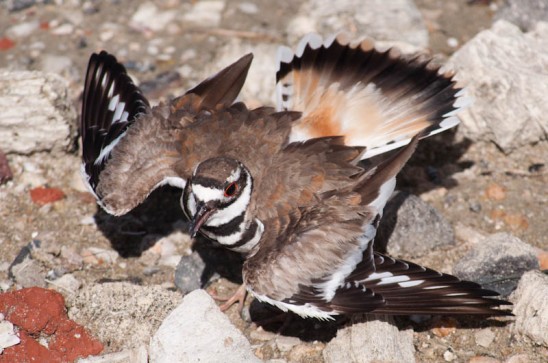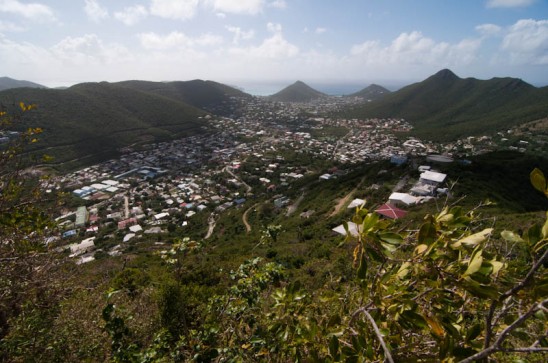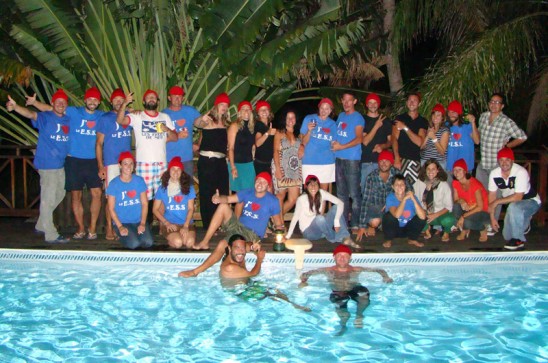March 11th, 2012 by Marc AuMarc

The salt flats surrounding Salines d’Orient serve as a nesting ground for several species of bird, and apparently the nesting season has begun. This killdeer (Charadrius vociferus) is brave enough to try to distract and intimidate humans near its nest, even though we are hundreds of times larger than it is. Camouflaged eggs and a dedicated parent are the only protection for a nest on the ground, and unfortunately, few chicks in the area survive until adulthood. Predators include mongoose and dogs, and the barely noticeable nests are also easily trampled by humans.
If you are in the area this time of year, it is best to avoid walking on the salt flats, or to do so very carefully, and keep dogs on their leash. This will at least give these brave birds a fighting chance to raise their young.
Posted in Les Fruits sur la Terre, Pour les Sciences
Comment on this post.
March 2nd, 2012 by Marc AuMarc
A couple weeks ago, I went with St. Martin Trails to clear some of the Crest Trail near Reward on the Dutch side of the island. After a couple hours of clearing trail, I found that the next portion of the Crest Trail was pretty clear so I decided to walk over to Paradis to meet friends at Loterie Farm.

The views were spectacular, and I believe that part of the trail that runs along an old slave wall may actually also be running along the border between the two nations on the island. There was also plenty of wildlife to be seen, including many tree frogs, the beautiful black witch moth and my first sighting of the zestos skipper. On the way down to Loterie Farm, I also passed the remains of the Sucrerie Loterie, sitting in the forest that has grown up around it since the days of colonial agriculture.
Posted in Explorations, Les Fruits sur la Terre
Comment on this post.
March 1st, 2012 by Marc AuMarc
Tucked away between Maho and the Simpson Bay Lagoon is a nice strip of scrub running along Pointe Pirouette. While killing some time between dropping off and picking up friends at the airport, I explored the overgrown dirt tracks that cut through the scrub and found a variety of interesting invertebrates.
The coolest thing I found were some debris-carrying lacewing larvae. These hunters camouflage themselves with various debris, including the exoskeletons of their prey. There were also plenty of stink bugs, katydid nymphs and fuzzy green weevils. Although the area may not be as beautiful or species-rich as some areas of the island, it’s a lovely, and accessible patch of scrub in an otherwise largely-developed area.
Posted in Explorations, Les Fruits sur la Terre
Comment on this post.
March 1st, 2012 by Marc AuMarc
We had the fourth annual Tacousteau, celebrating the works of our inspiration, Jacques-Yves Cousteau, and the delicious Mexican food tacos. Our first-ever snorkeling contest was won by Xander Petrelluzzi, who retrieved all seven submerged sea creatures on one breath in just 16.7 seconds!

Posted in Fruits News
Comment on this post.
March 1st, 2012 by Marc AuMarc
There are few cases when manmade construction actually preserves habitat, but on occasion it does happen. On a recent visit to Fort Amsterdam, I had the pleasure of seeing brown pelicans building their nests on the nearby cliffs. Although it’s impossible to know for sure, it definitely seems likely that if there were no ruins of Fort Amsterdam, the area would have been developed for tourism and the pelicans wouldn’t be nesting there. A win-win for history and natural history on the island.
Posted in Arts & Culture, Les Fruits sur la Terre, Pour les Sciences
Comment on this post.



































































